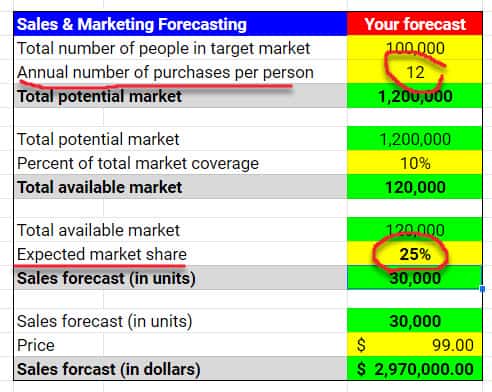How is “Free” used in marketing? (5 clever strategies)
“You get a car, she gets a car, everybody gets a car!” – Oprah Winfrey Oprah once gifted 300 audience […]
Read More »Become a successful marketing consultant: Learn more

Forecasting your sales is an art and a science.
While your sales forecast might be a best guess, with using some basic tools and strategies you can get a very good idea of your future sales.
The biggest benefit of sales forecasting is you get a projection of what your sales can become. By forecasting sales you can set sales goals, expectations, develop your marketing budget, have better inventory management and allocate supporting staff needs, among other benefits.
Sales forecasting is primarily a data hybrid between business analytics, marketing metrics and sales numbers.
Often, the roadblock to increasing sales is not always the sales and marketing team. A common block to optimizing sales is in inventory management, the actual production of the product or service and even the supporting staff being able to handle the workflow. These are called constraints and will be discussed in future forecasting tutorials.
There are many many ways to forecast your sales. In this tutorial we are going to review and give you a sample sales forecasting method that almost anyone can do without expensive software. All you will need for this example is Google Sheets or excel and some basic skills you can learn from YouTube videos or supporting docs.
The sales forecasting method we are going to review today is simply called our Sales & Marketing Forecasting model and you can use it for a new product or an existing product.
Before we dig into this forecasting model, let first briefly discuss some benefits of and methods of sales forecasting.
Have you ever asked yourself? …
These, and similar questions, are the ones CEOs, sales managers, and sales teams ponder daily.
The sales sector is your business’ lifeline, so having at least a general idea of what lies in the future helps you make better decisions. The answer to the questions on what to expect in future sales lies in sales forecasting.
Sales forecasting entails an estimation of the sales your company can expect over a specified period in the future.
Depending upon the business, sales forecasting can be quarterly, annually, half-yearly or weekly. Sales forecasting is often based on current economic trends, industry-wide comparisons, and past sales.
The following are some of the major benefits of sales forecasting for your products and services.
The ideal technique for forecasting sales depends on your service or product and your available sales data.
Sales forecasting methods are categorized according to their data input types into quantitative and qualitative methods.
Here is a brief summary of some of the common sales forecasting techniques:
Forecasting future sales of a new product is difficult.
One effective method is to test small and roll out bigger.
For example, if you have a customer list, you could sell your new product to a well defined number in your list. Let’s say you have identified 1,000 customers.
Once you determine a conversion rate, let’s say you sell 100 products to this segment of your list, now you have a 10% conversion rate to your house list. Now you have something to work with.
For this simple example, if you have a list of 100,000 customers, you can forecast that 10% of your list will purchase your new product and you will sell 10,000 products.
But most new product forecasting isn’t so straightforward. In fact, most sales forecasting is much more “muddy”.
There is no method from the above touted as the best for forecasting the sales of your new product or service. Below are the basic steps of sales forecasting for a new product, irrespective of the method you choose.
When considering what will work best for your brand, here are some tidbits to keep in mind:
Now let’s continue with our previous example of targeting our customer list of 100,000 and assuming a 10% conversion rate. Here’s an example model that you can use to forecast your sales. Notice for this example, this product is just a 1 time per year purchase.
Now, let’s change the model to assume your product may be a monthly purchase, or 12 times per year. Based on your business, you can change the expected market share based on your data and or your experience.
Here’s what this sales forecast looks like:
Go here to access the Google Sheets version of this Sales & Marketing Forecasting Model
It is free for your use. Go to File > Download > Microsoft Excel (or whatever you want) to save it for yourself.
Sales forecasting is an art and science that will significantly affect your success in business.
The time and money you spend on this crucial aspect will thus not go to waste.
Though you have gleaned a general idea of what to expect from sales forecasting from the information above, it is not as straightforward as you might assume. Some challenges you might face include unpredictable markets, seasonality, and insufficient data.
Get an experienced and trusted Strategic Marketing Partner help you achieve the highest possible benefits.